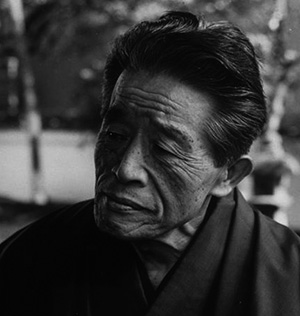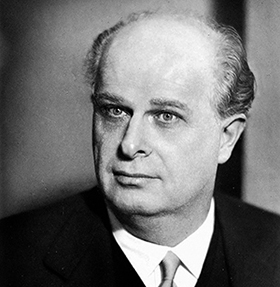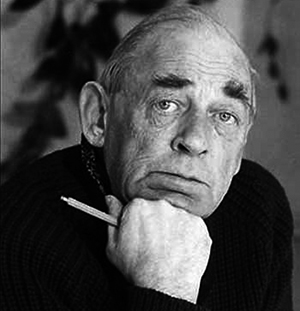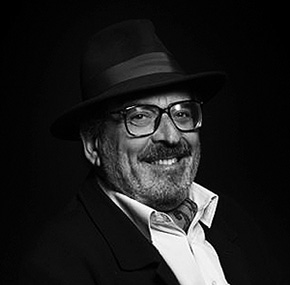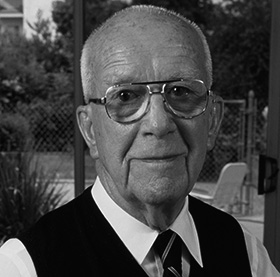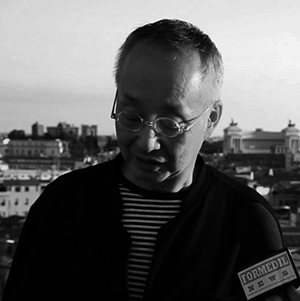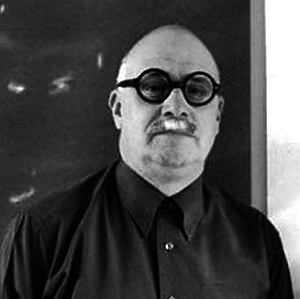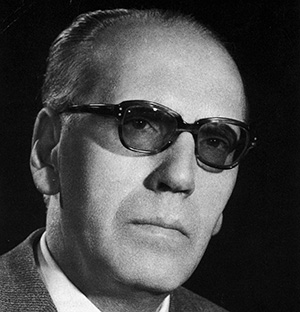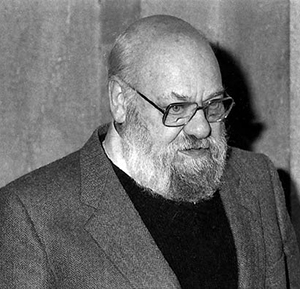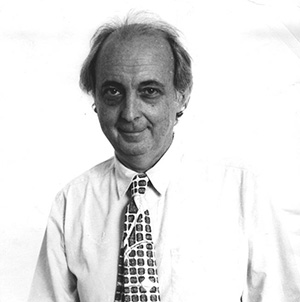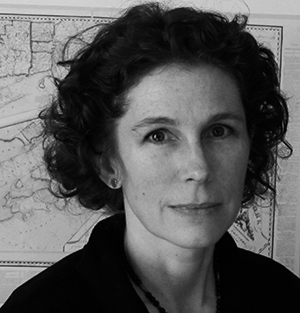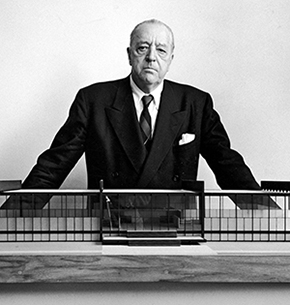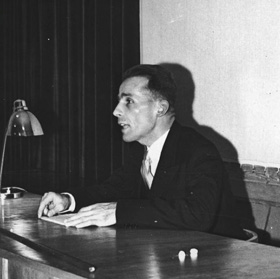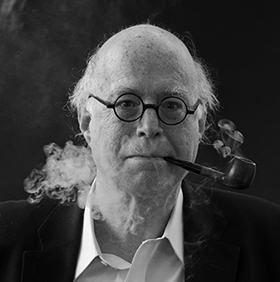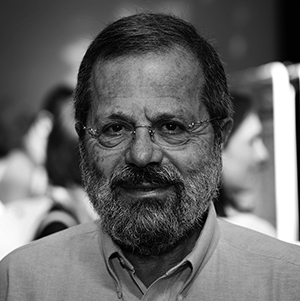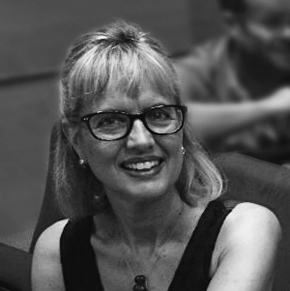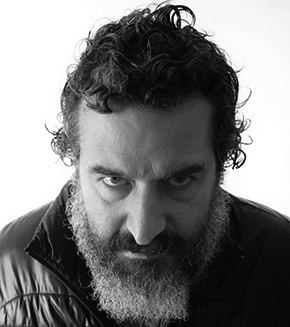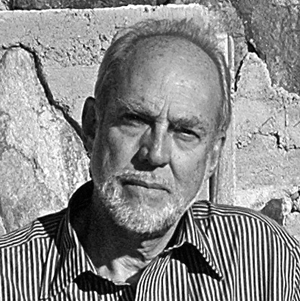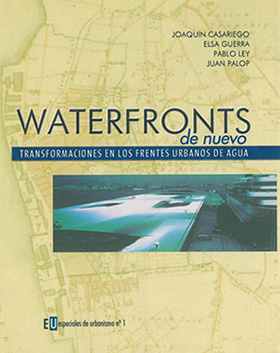Address to RIBA 1957
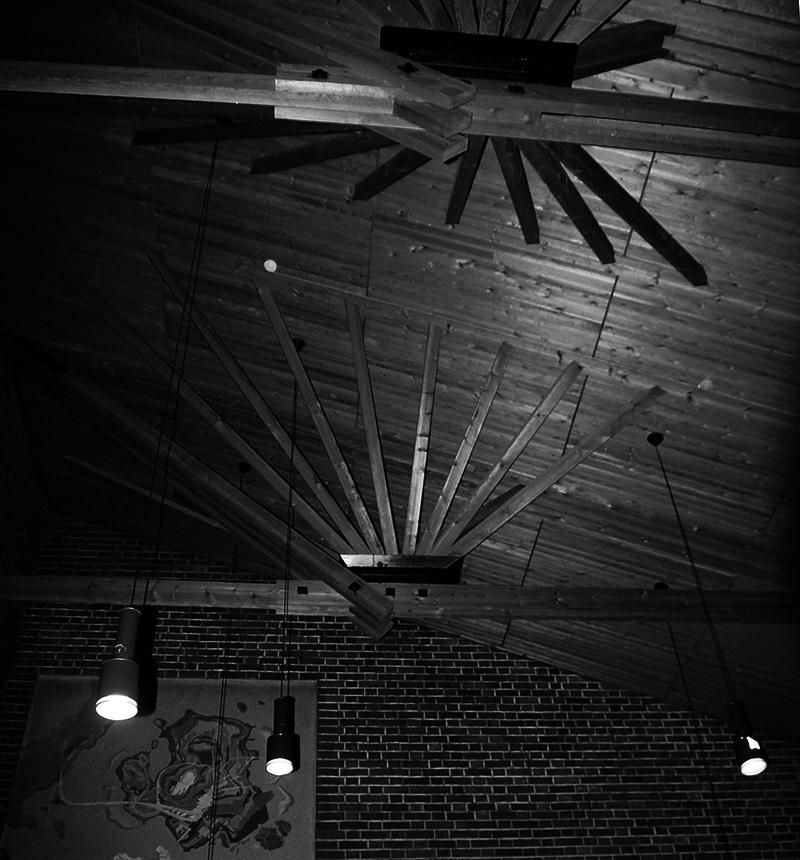 Ceiling Council Chambers at City Hall Säynätsalo. Photos: Trevor Patt, Flickr
Ceiling Council Chambers at City Hall Säynätsalo. Photos: Trevor Patt, Flickr
Alvar Aalto was an architect of few words. More confident in their own works to express their ideas on what should be the architecture and urbanism of the twentieth century. Mientras otros insignes Representantes de la arquitectura del Movimiento Moderno como, atesoraban todo lo que escribían. Es que Conocido Le Corbusier publicaba rigurosamente en la famosa Complete ouvre Trabajos y sus textos acompañados numerosos de dibujos y fotografias ilustrativas.
Wave, however, no I do not Sol prodigarse escritos más sobre su trabajo under the de su lengua natal, el Sueco. Lo que hace que sus opiniones sobre la arquitectura sean poco conocidas tanto en el pasado como en Nuestros días.
In 1957, members of the Royal Instituteof British Architects awarded him its traditional annual Gold Medal for the occasion offered at the London headquarters of the institution the next conference we have translated for publication here. Perhaps his ideas sound a little child today, but some of them are still relevant premonitory.
This text appears in the anthology compilation of 75 Aalto lectures and essays he published Goran Schildt in 1998 under the patronage of publisher Rizzoli New York.
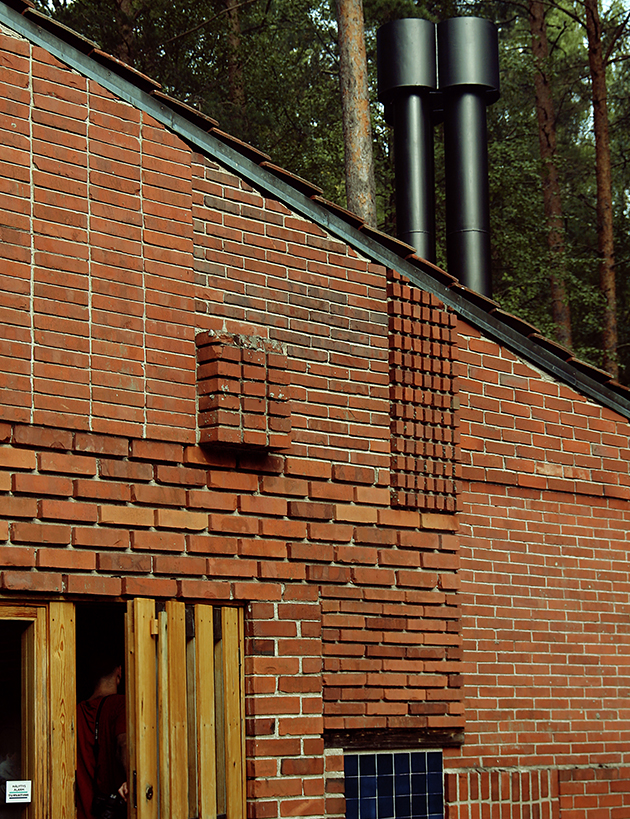 Detail cutting of brick factories in the courtyard of the House Muuratsalo. Photos: Trevor Patt, Flickr
Detail cutting of brick factories in the courtyard of the House Muuratsalo. Photos: Trevor Patt, Flickr
Our time is full of enthusiasm and interest- for architecture due to the revolution that is experiencing this art in recent decades.
Today, world, There are a small percentage, very small, construction really good and human. The truly civilized cultural creations are too few in each country, and not only in mine. I think the percentage is the same in all European nations. Just over a 2 or 3 % Country. It should be noted history to understand that the activities of architects should seek a reasonable increase in the minimum volume of good construction and urban planning at the service of humanity.
The architectural revolution that is taking place is like all revolutions: enthusiastically begins and ends with some form of dictatorship. Is out of its lane and separated from targets. There is one good thing in all this is happening today: There are creative people and groups that are considered architects organized in many parts of the world-perhaps in Uruguay, perhaps in Scandinavia, perhaps in England, perhaps in South Africa- posed new ways to work for their country, Slow, as formal artists, have been striving to fill a new field; today are garde d'honneur, cavalry squadron fight hard to humanize technology in our time.
I recently had a conversation with a client in Paris on a simple thing like the ventilation. Said: technique sans esprit is the worst thing in the world-what is true. There are only two things in art: humanity or lack. Naked form, specific details, do not create a good humanism. We have excess surface architecture – and bottom, bad – Modern is considered. Take the example of a city of entertainment, as Hollywood. Course, All buildings are modern. However, one can find very few that offer a proper sense to the real lives of the people who use and inhabit.
Let the other end. A few months ago an architect visited the snowfall Indian Finland-I think it was from Bombay and New Delhi- had a notebook where he was aiming all the questions considered important in relation to the art of building. Sentadoallí, the first thing I asked after greeting was: What is the modulus of this office? I did not know that answer because I really did not know. One of my assistants responded by saying: Maybe an inch or less.
Nowadays, above is an example of the extremes in running any usual discussion, second, the meaninglessness of it all: finding a module, a prescription that serves equally for everybody. Represents while, dictatorship in just growing revolution and slavery related technical trivialities which people undergo and, in themselves, not contain an iota of humanity.
The reasons why real culture is limited to a 2, a 4 the, even 5 percent of all human production, are deep and difficult to analyze. It is the great question of our time; is the issue of greatest significance for civilization and culture that dates back to the eighteenth century when industrialization surgela. There, course, enormous obstacles so we can live better. This, course, it hurts and can not be addressed peacefully. There are things that can and should be removed only by the goodwill. And if we look at those things, I think we could get a greater amount of good things for our fellow democracy in today.
We should remember the great epochs of literature, Voltaire time, Rousseau, or even after. We have Bernard Shaw, Strindberg or Anatole France. Why these men are great? By exercising criticism, also art in its highest expression; while, fighting to change things. Can not think of Bernard Shaw not always perceive it as a fighter. At its deepest meaning, I think the struggle and art in its supreme expression relate to each other. It may be that there is an art of excellence without containing that mysterious combination
I think the architectural institution, discussion and contact, well as our public speaking should be similar to those ejercenla literature. Course, architecture and literature are very, very different, very far from each other, sometimes beyond the reach of sight.
What are the main obstacles to absolute production that can qualify as a good architecture? I can not know all, but I can pick a few drawbacks that could well be eliminated.
First, there is a huge difficulty to educate people regarding architecture wing. Artistic estaforma requires access to numerous fields of knowledge, and an unusual culture before we can answer that people can understand. On one occasion being here in England I felt very comforted when I saw a small textbook that offered basic knowledge on architecture. He was addressing young children of elementary school. I think it's good to do that, but I'm scared to recognize that architecture that spans the world of structures and forms that exist around us is a subject too complicated to teach children in that part of their lives that childhood esla. Probably, architecture teach children seven or eight years is like teaching sexuality to those at the beginning of primary education.
But I also think at higher levels can give a better education, I should not follow the same path as regular art criticism. Art criticism has more than a century. The use of writing articles on the work of specific artists should not be much older. Should be analyzed for individual architects. Explain that the right path in this field is the planning and building service-oriented democratic man, for your benefit.
We understand that the best method is to teach real and concrete examples. Say, a small group of houses and other architectural spaces, and allow people to see them and experience them. We work in a field unfortunate since we have no prior experience of laboratory. We are the only professionals in the modern industrial world we have to design and manufacture directly. There should be a trial period in between these two moments. Can be individually, but all true civilized nation should have a program of experimental neighborhoods and buildings. England has this for quite some time. Seeing the fact we could talk about the developments of Raymond Unwin, or Weissenhofsiedlung colony in Germany, where there has been avant-garde art, individual art, but they really are not those laboratories Spoken. I think that it is possible to educate people about how they should live without this kind of initiatives.
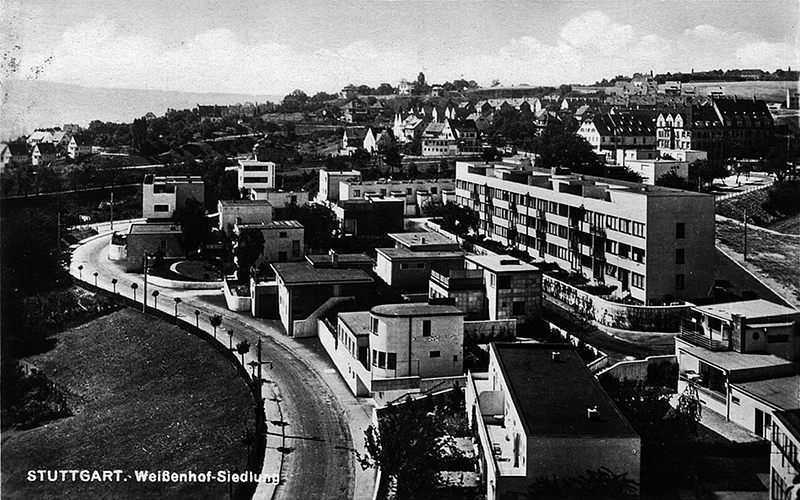 Neighborhood Weissenhof in Stuttgart 1927
Neighborhood Weissenhof in Stuttgart 1927
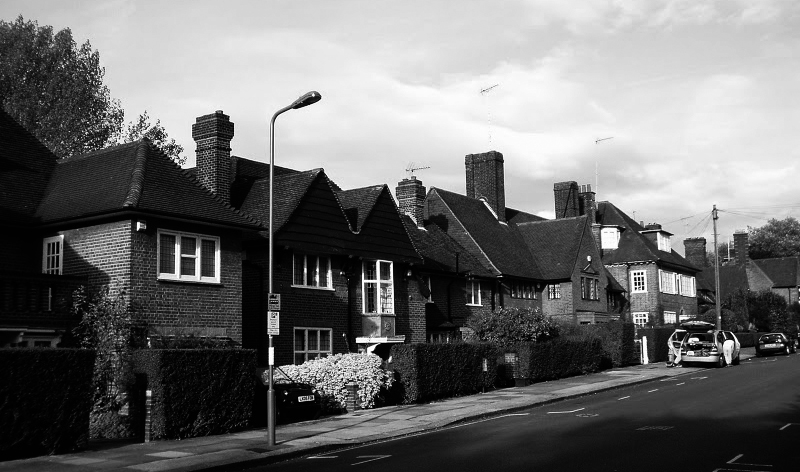 A street in the Hampstead Garden Suburb.Una of the best developments of Raymond Unwin. Photo Steve Cadman, Flickr
A street in the Hampstead Garden Suburb.Una of the best developments of Raymond Unwin. Photo Steve Cadman, Flickr
Consider mechanization, standardization of our time as a second question. We all know what the mechanization of our lives; democracy is a part dela. Esla only way to give more things to more people. At the same time, understand that mechanization and standardization always reduce the quality of what we received. This means that biological democracy is a very difficult process. We can not give everyone the same quality as getting a few people in the past.
It's crazy, expresses the enormous difficulties that we have to offer the same level of quality and give equal. It's even harder when we consider moving from the material qualities to the qualities of the spirit. Then our world today presents us pretty bad.
But there are possibilities to use mechanization and standardization for the benefit of human. The question is what we should should streamline and standardize? We can make standards that improve the level not only of life but also spiritual. One very important thing should be to promote standardization elastic, standardization not force us, but to which we can control. Little by little, a dictatorship of the machines acts upon us, more and more. We use deeper intellectual methods: And in this case, if you sent it out on materials, the names of these methods would be the architecture itself and nothing else, and create a standardization that has human qualities. We could look for things that have human qualities. Homes that give people more. It's not about how many or few power lines should be standardized motorized parts; but when we come to the man's house, to those things which are coming to us, understand that the problem is different: becomes a spiritual issue, becomes an intellectual above that chapter standardization speech.
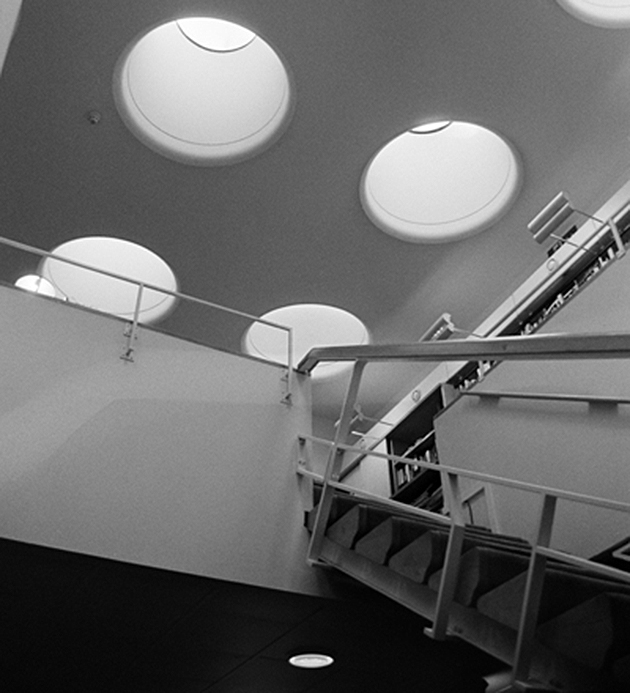 Staircase Rautatalo office building in which is rung design that refers Aalto in his dissertation
Staircase Rautatalo office building in which is rung design that refers Aalto in his dissertation
I once tried to make a ladder they could standardize. We designed this new stair steps in connection with the houses we used to do, but standardized step depends on the height of the building and many other different requirements. You can not always use the same step, because it has sufficient elasticity so you can get anywhere. We try to solve the problem with a kind of versatile system by which steps could be adapted, so that the ratio of the vertical and horizontally to maintain that ratio is a formula with which all architects from Renaissance times-I think from Giotto, or before, from the time of Pericles. Because the movement of the human being responds to a particular kind of rhythmic way. You can not do a step as you dare, must respond to a very specific. I once talked about this at the University of Gothenburg. The Rector said: Stop for a moment, I want to check something on the library. He left the auditorium downstairs and returned with a book, the Divine Comedy Dante. He opened it to a specific page, saying that the worst thing you could have in the Inferno is having to climb a ladder that does not have the proper proportions.
Is considering these little things that we can build a harmonious world for people. It is possible for anyone who seeks to address these problems and is based on understanding it ending those who have the responsibility of managing the ordinary.
I'll tell you about a thing; concerns which means that architects have to work with huge amounts of money. Any work we do is a big investment. Urban planning is perhaps the greatest of these applications spending. Just changing the traffic is so expensive today one thing that people can not assume that change in the political and practical. Today we know that the common man lives surrounded by cars. Every minute, even in the smallest town, Motor hundreds of machines are rolling to pedestrians, these young men democratic. For this we are all in a situation much worse that engineers are in a paper factory eight hours a day. In such factories no engines, electro only transmitters, and if there are very few engines. But on the streets there are hundreds of engines circulating all the time. Our streets and cities were designed with completely different goals - including the magnificent Boulevard des Italiens - for horse traffic, a few horses here and there. Now car is packed and we know that this fact is not neutral. They emit poisonous gases that remain in the streets. Maybe my friends who have a high level of medical care are paying a steep price because of our inability to build a different system traffic where pedestrians and cars are well apart from each other. Not to mention the homes, should be further away. The answer that emerges is cancer that price.
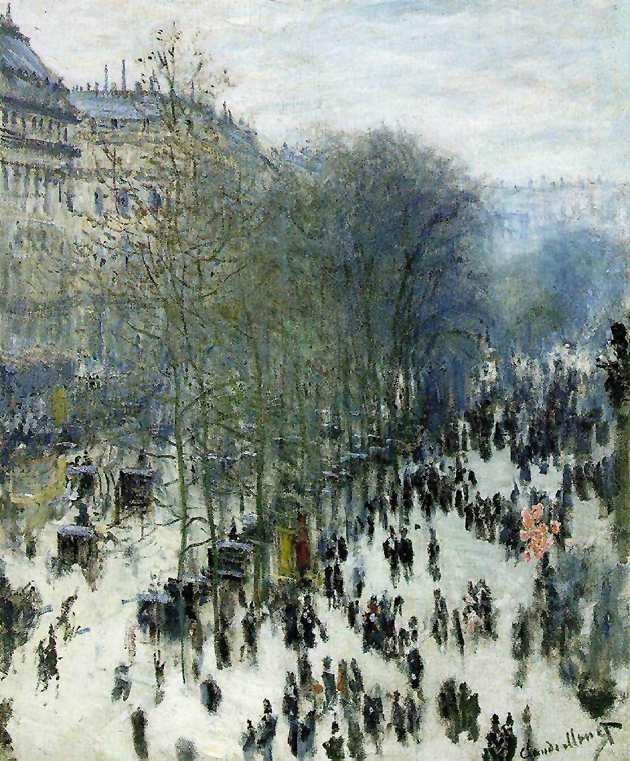 A Parisian boulevard Claude Monet
A Parisian boulevard Claude Monet
Then there is our old enemy, the speculator. That is the number one enemy of the architect. But there are other enemies, too, which are even more difficult to kill. For example, in my country we have - and similarly there are other places because in regard to this issue we are all on the same level – theoretical economics applicable to building construction is presented saying popularly: What kind of house is cheaper? If we, say for example, five-story building, six or even eight apartments then the question arises: What should be the width? What long? What is the cheapest way we can consider to house the people who need it urgently? Of course we can call this science. But it is. The answer is simple, fairly simple. The most compact home is the cheapest. That is clear. One can go further and say that the most inhumane house is the cheapest., that lighting is more expensive than we have daylight-'s keep out, and then we have the cheaper housing. The most expensive is good fresh air, because it is not a question of ventilation, but a matter of urban planning. The outdoor hectares of land costs, good gardens and forests and meadows.
The real economy of the buildings can not be addressed in this way ridiculous. The real economy of the building should refer to how many good things we can achieve at a reasonable cost. And we must not forget that we built for people. It's the same in any kind of economy - the correct relationship between the quality and price of a product. But if you leave the warm product for the sake of lower cost, all of the supposed economy becomes meaningless in any field, it is also applicable to the architecture.
This way of seeing things is very suitable for propaganda: a form of advertising that uses the word "economy" in an inappropriate manner, is anti-human. Sometimes it goes so beyond that is the same in the opposite. I know schools that are applying this form of propaganda and, probably, achieve lower costs in their numerical tables but it sure kids pay dearly.
Let me reflect more on these issues. And jump to the world economic considerations dela decoration. Sabemosque the world has a life independent decorative. There are industrial art has no relation to the base architecture dela. Esdecoración you can put anywhere.
This is a very comical, streamlining means that unwise, this rationalization that leads to anti-humanism, by the wrong use of the word economy and decor are the trois cochons working together. A week ago, in Switzerland saw long lines of buildings made of standard mechanical way without any intention but with a fine decorative. The decoration was used to cover those monstrosities that would otherwise seem harsh and inhumane.
But this triangular activity leads to a society uneducated and soulless buildings - the result of the combination of those three things that do not correspond. We have a society inorganic. We should work to make things simple, good and without decoration, things that are in harmony with the human being and organically adjusted to the real needs of the people we meet on the streets.
And now I will explain a few things with images. Some time ago I gave a lecture in Venice in which I tried to provide a philosophical perspective, but the reception was very low. The people there said: Not only philosophically believe, because we are not professional philosophers; we would like to understand why you do this and that in your buildings because if you show, we criticize and know is right and who is wrong. With simple words can tell all the truths you want without being able to criticize.
It may be a tradition for architects who like me are a bad philosophers, we show something open to criticism and establish criteria for what we say in words. So now I'll show you some pictures. Without being a critic, I can not criticize my colleagues, but I can show you some things that relate to my own buildings. Do not show with some purpose, so a few words about the effect they will do what the people of Venice as the only right way to talk about architecture.
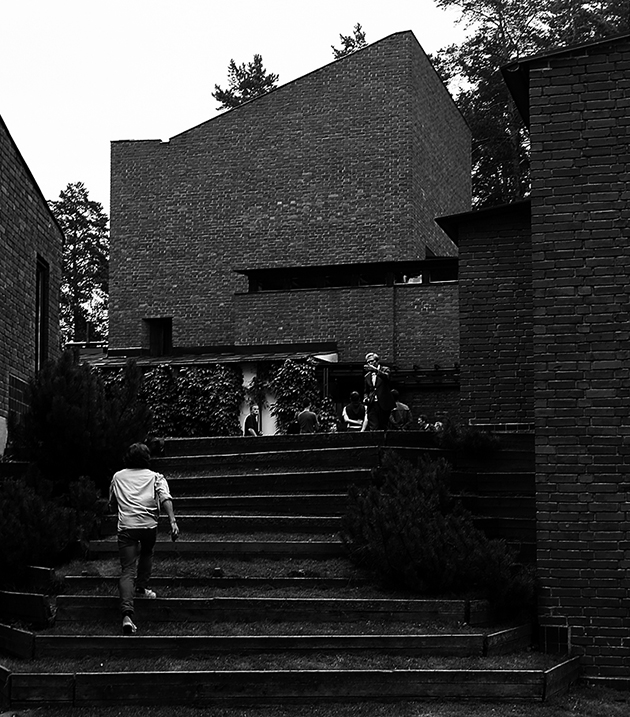 Civic Center Access Säynätsalo. Photos: Trevor Patt, Flickr
Civic Center Access Säynätsalo. Photos: Trevor Patt, Flickr
This is the Civic Center Säynätsalo. It's kind of small town council for this. Only has an area of a few tens of square meters. And it had to be small for a small town. That people can not grow because it is limited by the length of the island on which stands. The square has been placed above, four meters, the roads around. Say democratic meetings - if their inhabitants do these things- should be here in this room, that will always be away from motorized vehicle access. I think it's one of the ways to solve the problem of traffic and overlap between human beings, defining a different level for each. Probably, This is, today, the simplest. In any case, verticality there is a problem and not just a problem of separating horizontally.
First we do things by instinct and then finally found a reason. In my case, always an 80% in this way and only a 20% I come first reason. This photograph is one of those cases where the reason emerged first. There, winter, it is cold and summer is a lot like this place where we are. The temperature difference between winter and summer is 17 º C, which is quite. That means that in the winter time you have to control condensation and summer must expel the heat that builds up. So there should be a ventilated space between the outer and inner roof. The majority of roofs are projected there these two elements, main plate andthe secondary. Parallel Aquíambas, so that air flows in between along the entire space. That is the reason for having placed this kind of "butterflies", because this piece main constructive support to the other two, which means that I had no place other secondary parts inside, and allowing the passage of air.
We see here the Rautatalo office building with covered patio which has placed a coffee.
This one is from the seat dela National Pension Institute in Helsinki. Inside the restaurant is showing heating panels on your roof.
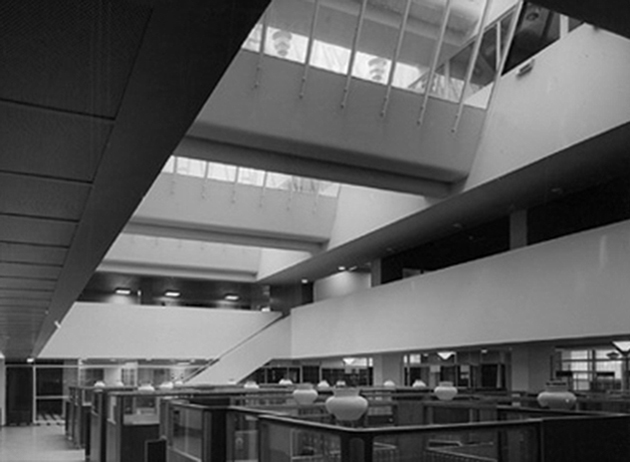 At the National Institute of Pension, skylights in the room with their customer service desks for private interviews.
At the National Institute of Pension, skylights in the room with their customer service desks for private interviews.
More Information:
Aalto in his own words. Peter Davey on Goran Schildt book.
